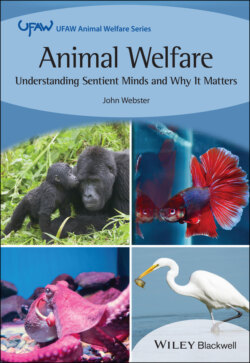Animal Welfare

Реклама. ООО «ЛитРес», ИНН: 7719571260.
Оглавление
John Webster. Animal Welfare
Table of Contents
List of Tables
List of Illustrations
Guide
Pages
The Universities Federation for Animal Welfare
Animal Welfare. Understanding Sentient Minds and Why it Matters
About the Author
John Webster
Preface
Acknowledgements and Apologies
Part 1. The Sentient Mind: Skills and Strategies
1. Setting the Scene
Human Attitudes to Animals
Animal Behaviour Science
Rules of Engagement
2. Sentience and the Sentient Mind
Sentience, Consciousness and the Mind
The Five Skandhas of Sentience
Understanding the Sentient Mind
Pain and Suffering
Pain: How do We Know It Matters?
Fear and Dread
Coping with Challenge: Stress and Boredom
Social Life
Comfort and Joy
Hope and Despair
Sex and Love
Summary
3. Special Senses and Their Interpretation
Vision
Hearing
Smell and Taste
Cutaneous Sensation, Touch
Magnetoreception
Interpreting the Special Senses
Theory of Mind, or Metarepresentation
Summary
4 Survival Strategies
Foraging
Hunting Behaviour: The Predator and the Prey
Spatial Awareness and Navigation
Breeding Behaviour and Parental Care
5 Social Strategies
Sentient Social Life
Social Hierarchies: The Pecking Order
Communication
Cooperation and Empathy
Social Learning, Education and Culture
Territorial Behaviour and Tribalism
Part 2. Shaping Sentient Minds: Adaptation to the Environment
6 Animals of the Waters
Box 6.1 The Food Chain in the waters
Pain and Fear
Survival Skills: Hunting, Hiding and Problem Solving
Migration
Communication and Social Behaviour
7 Animals of the Air
Feeding Strategies
Migration
Sentience and Breeding Behaviour
Social Behaviour, Culture and Education
Bats
8 Animals of the Savannah and Plains
Environmental Challenges
Animals of the Open Plains
Sheep
Goats
Cattle
Wild Bovidae
Feral Horses
Elephants
Predators
9 Animals of the Forest
The Boreal Forest
Cervidae
Beavers
Bears
The Tropical Rain Forests
Snakes
Primates
10 Close Neighbours
History of Domestication
Artificial Selection and Unnatural Breeding
Domestication, Sentience and Wellbeing
Pigs
Dogs
Cats
Dairy Cows
Horses and Donkeys
Chickens
Opportunist Neighbours: Rats and Urban Foxes
Coda
Part 3. Why it matters: Nature's Social Union
11 Our Duty of Care
Sentience Revisited
Outcome‐based Ethics
Death and Killing
Farms, Farmed Animals and Food
Animals in Laboratories
Wild Animals in Captivity
Animals in Sport and Entertainment
Pets
What can We Learn from the Animals?
Further Reading
General Reading
Index
WILEY END USER LICENSE AGREEMENT
Отрывок из книги
UFAW, founded in 1926, is an internationally recognised, independent, scientific and educational animal welfare charity that promotes high standards of welfare for farm, companion, laboratory and captive wild animals, and for those animals with which we interact in the wild. It works to improve animals’ lives by:
.....
These two instances of mindless ill‐treatment may be attributed to ignorance. However, ill‐treatment on an industrial scale, carried out with the approval of the highest authorities, remains a problem in the so‐called developed world and to the present day. The number of chickens killed and consumed by humans every day is approximately 70 million. Furthermore, most of them are unlikely to experience much that could be quality of life before they die. In the words of Ruth Harrison, the godmother of the Animal Welfare movement: ‘If one person is unkind to one animal, it is considered as cruelty but when a lot of people are unkind to a lot of animals, especially in the name of commerce, the cruelty is condoned and, once large sums of money are at stake, will be defended to the last by otherwise intelligent people’ (29). It was Ruth who pointed out the absurdity of the UK Protection of Birds Act (1964) which required any caged bird to be given enough space to flap its wings but then stated ‘provided this subsection does not apply to poultry’. This subsection meant that, at the time, the Act did not apply to about 99% of caged birds. This is perhaps the most egregious example of the fallacy of classifying animals as commodities in term of their utility to us, rather than as sentient beings whose minds have been shaped by their genetic inheritance and their individual experience of life. It was sustained public pressure generated by pioneers like Ruth Harrison that compelled the European Union to pronounce in the Treaty of Amsterdam that ‘Members shall, since animals are sentient beings, pay full regard to the welfare requirements of animals’ (73). This is a clumsy sentence from a clumsy clause that is also littered with caveats and exceptions for regional and religious practices. Nevertheless, it did recognise in law the principle that animals used by us for food, scientific enquiry, or health and safety legislation should not be considered simply as commodities but treated with respect and concern for their wellbeing.
This exploration of the minds of sentient animals draws heavily on scientific studies of animal psychology and behaviour. The scientific investigation of animal behaviour is concentrated on two main themes. The first is the study of how animals behave in their natural habitat. This can establish their behavioural needs and the actions they perform to meet these needs. From this, we can build up a reasonably comprehensive picture of the resources (e.g. diet, physical and social environment) they require to achieve a sense of physical and mental wellbeing. With this information to hand, we can devise management policies that seek to address these needs whenever we modify their natural habitat to suit our own needs for food, companionship, sport, safety or scientific endeavour.
.....